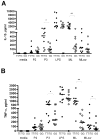Human TLR1 deficiency is associated with impaired mycobacterial signaling and protection from leprosy reversal reaction
- PMID: 18461142
- PMCID: PMC2330092
- DOI: 10.1371/journal.pntd.0000231
Human TLR1 deficiency is associated with impaired mycobacterial signaling and protection from leprosy reversal reaction
Abstract
Toll-like receptors (TLRs) are important regulators of the innate immune response to pathogens, including Mycobacterium leprae, which is recognized by TLR1/2 heterodimers. We previously identified a transmembrane domain polymorphism, TLR1_T1805G, that encodes an isoleucine to serine substitution and is associated with impaired signaling. We hypothesized that this TLR1 SNP regulates the innate immune response and susceptibility to leprosy. In HEK293 cells transfected with the 1805T or 1805G variant and stimulated with extracts of M. leprae, NF-kappaB activity was impaired in cells with the 1805G polymorphism. We next stimulated PBMCs from individuals with different genotypes for this SNP and found that 1805GG individuals had significantly reduced cytokine responses to both whole irradiated M. leprae and cell wall extracts. To investigate whether TLR1 variation is associated with clinical presentations of leprosy or leprosy immune reactions, we examined 933 Nepalese leprosy patients, including 238 with reversal reaction (RR), an immune reaction characterized by a Th1 T cell cytokine response. We found that the 1805G allele was associated with protection from RR with an odds ratio (OR) of 0.51 (95% CI 0.29-0.87, p = 0.01). Individuals with 1805 genotypes GG or TG also had a reduced risk of RR in comparison to genotype TT with an OR of 0.55 (95% CI 0.31-0.97, p = 0.04). To our knowledge, this is the first association of TLR1 with a Th1-mediated immune response. Our findings suggest that TLR1 deficiency influences adaptive immunity during leprosy infection to affect clinical manifestations such as nerve damage and disability.
Conflict of interest statement
The authors have declared that no competing interests exist.
Figures



Similar articles
-
Toll-like receptor 1 N248S single-nucleotide polymorphism is associated with leprosy risk and regulates immune activation during mycobacterial infection.J Infect Dis. 2013 Jul;208(1):120-9. doi: 10.1093/infdis/jit133. Epub 2013 Apr 1. J Infect Dis. 2013. PMID: 23547143
-
The TLR1 gene is associated with higher protection from leprosy in women.PLoS One. 2018 Oct 5;13(10):e0205234. doi: 10.1371/journal.pone.0205234. eCollection 2018. PLoS One. 2018. PMID: 30289892 Free PMC article.
-
A common human TLR1 polymorphism regulates the innate immune response to lipopeptides.Eur J Immunol. 2007 Aug;37(8):2280-9. doi: 10.1002/eji.200737034. Eur J Immunol. 2007. PMID: 17595679
-
Leprosy susceptibility: genetic variations regulate innate and adaptive immunity, and disease outcome.Future Microbiol. 2011 May;6(5):533-49. doi: 10.2217/fmb.11.39. Future Microbiol. 2011. PMID: 21585261 Review.
-
Learning from leprosy: insight into the human innate immune response.Adv Immunol. 2010;105:1-24. doi: 10.1016/S0065-2776(10)05001-7. Adv Immunol. 2010. PMID: 20510728 Review.
Cited by
-
Human polymorphisms as clinical predictors in leprosy.J Trop Med. 2011;2011:923943. doi: 10.1155/2011/923943. Epub 2011 Dec 18. J Trop Med. 2011. PMID: 22220182 Free PMC article.
-
Genetic variation of the human urinary tract innate immune response and asymptomatic bacteriuria in women.PLoS One. 2009 Dec 15;4(12):e8300. doi: 10.1371/journal.pone.0008300. PLoS One. 2009. PMID: 20016852 Free PMC article.
-
Allele-specific induction of IL-1β expression by C/EBPβ and PU.1 contributes to increased tuberculosis susceptibility.PLoS Pathog. 2014 Oct 16;10(10):e1004426. doi: 10.1371/journal.ppat.1004426. eCollection 2014 Oct. PLoS Pathog. 2014. PMID: 25329476 Free PMC article.
-
NOD2 triggers an interleukin-32-dependent human dendritic cell program in leprosy.Nat Med. 2012 Mar 25;18(4):555-63. doi: 10.1038/nm.2650. Nat Med. 2012. PMID: 22447076 Free PMC article.
-
A TLR6 polymorphism is associated with increased risk of Legionnaires' disease.Genes Immun. 2013 Oct;14(7):420-6. doi: 10.1038/gene.2013.34. Epub 2013 Jul 4. Genes Immun. 2013. PMID: 23823019 Free PMC article.
References
-
- Casanova J-L, Abel L. Genetic dissection of immunity to mycobacteria: the human model. Annual Review of Immunology. 2002;20:581–620. - PubMed
-
- Fernando SL, Britton WJ. Genetic susceptibility to mycobacterial disease in humans. Immunol Cell Biol. 2006;84:125–137. - PubMed
-
- Remus N, Alcais A, Abel L. Human genetics of common mycobacterial infections. Immunol Res. 2003;28:109–129. - PubMed
-
- Alcais A, Mira M, Casanova J-L, Schurr E, Abel L. Genetic dissection of immunity in leprosy. Current Opinion in Immunology. 2005;17:44–48. - PubMed
Publication types
MeSH terms
Substances
Grants and funding
LinkOut - more resources
Full Text Sources
Medical
Miscellaneous

